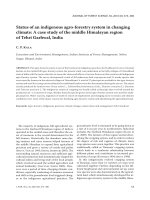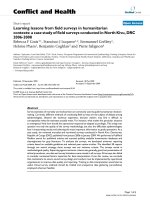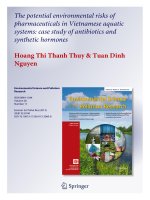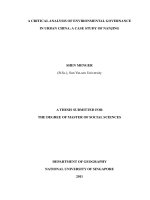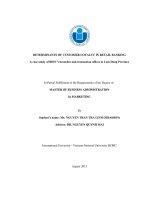HUMAN RESOURCE MANAGEMENT IN VIETNAMESE STARTUPS: A CASE STUDY OF COC COC COMPANY
Bạn đang xem bản rút gọn của tài liệu. Xem và tải ngay bản đầy đủ của tài liệu tại đây (1.2 MB, 96 trang )
FOREIGN TRADE UNIVERSITY
FACULTY OF BUSINESS ADMINISTRATION
-----------------
GRADUATION THESIS
Major: International Business Management
HUMAN RESOURCE MANAGEMENT
IN VIETNAMESE STARTUPS: A CASE STUDY
OF COC COC COMPANY
Student name
: Trinh Thi Hoai Thuong
Student code
: 1211260036
Class
: Advanced Business Administration
Intake
: 51
Supervisor
: Assoc. Prof. Dr. Nguyen Thu Thuy
Hanoi, May 2016
ACKNOWLEDGEMENTS
First I would like to send my most sincere gratitude to my thesis supervisor
Associate Professor Dr. Nguyen Thu Thuy for her incredible expertise, gentleness
and kindness in instructing me throughout this difficult process. Without her great
orientation and support, I would not have been able to complete this thesis. Working
with and learning from her has been one of the best privileges and inspiration I have
had in my student life, which played an important part in shaping my future dreams
and ambition.
Credits also go to my dear friends, Dang Quang Huy, Le Nguyen Ha An and
Nguyen Vinh Bao for great access to wonderful sources of research and references I
could not manage to find elsewhere.
Also let me express my love to the most fun and helpful roommate in the
world, Tran Thi Phuong Thao, whose tolerance and kindness knew no bounds when
she helped me out through such a busy and stressful time.
I am also indebted to my program manager, Dr. Nguyen Thuy Anh, my
amazing classmates and lecturers for making my FTU memory priceless.
And above all, my heart goes to the most wonderful blessing of my life: my
family for all their unfailing listening, loving and caring who are desperate to have
their child home but had to patiently wait until graduation thesis - my last mission is
completely done. This is the beginning of a new chapter we are going to go through
together.
I am grateful to have you all in my life.
Hoai Thuong
LIST OF ABBREVIATIONS
HR
Human resource
HRM
Human resource management
HCM
Ho Chi Minh
KPI
Key performance indicator
FMCG
Fast-moving consumer goods
TABLE OF CONTENTS
LIST OF FIGURES
Age groups of respondents……………………………………………61
Figure 4.11 O*net job analysis…………………………………………………….78
LIST OF TABLES
8
CHAPTER 1. INTRODUCTION
1.1 Background
The new evolving business environment under profound changes and soaring
competition has pressurized worldwide organizations to focus intensely on the
human factor. Across from service to manufacturing and traditional sector, gone are
the days when employees have to shape themselves to fit into work system. Instead,
it is firms and companies’ responsibility to create the best working environment
possible for staff to bring out their best. The fifth edition of RSM insight by
Erasmus Mundus university (Rotterdam) points out: “Understanding how
workplaces can be designed with people in mind should be of great interest to
organizations”. Growing appreciation of how properly selected, trained and
rewarded workers can help a business step forward means Human Resource
Management occupies more power than ever.
All over the world vibrant HRM practices are maintaining and developing.
Since 1973, out of the famous “People-Service-Profit” philosophy, FedEx
corporation - top delivery company has applied cutting-edge technology to keep
track of its employee satisfaction. That system was invented based on an annual
survey and a feedback action program. Meanwhile, HRM at Twitter is strongly
engaged with creativity and leadership, keeping the company on Glassdoor’s list of
leading workplaces of the tech industry. More innovatively, there even rises a trend
for companies to make an app exclusively for attracting, hiring and training new
talents. It is no doubt that Human resource professionals have come to view
workforce planning as part of strategic development that requires careful
consideration as well as data and analytic tools to assist.
Given its prime importance, how does the HRM landscape in Vietnam look
like? Except for MNCs which employ globally standardized HR frameworks and
9
models from outside, namely Unilever, HSBC, Samsung, SONY,… HRM still
remains a function largely overlooked by top management executives elsewhere.
Most of these business owners do not participate in formal management courses to
equip themselves with full understanding of modern business administration. Under
the title of “Common human resource practices in Vietnam SMEs”, a nation-wide
research by the National center for information and forecast of social economy
points out: only few SMEs make long-term manpower planning. As low as 25% of
all companies advertise job vacancies on mass media while slightly more than a
third make recruitment evaluation. The vast majority (85%) of companies produce
human resource forecast based on labor turnover rate, whereas only 15% refer to
technological advances, service demand and supply, capital scale,… for broader
perspectives. In addition, assessment of labor shortage or surplus is also carried out
solely by individual department in proportion with current workload and totally
without direct involvement of Human resource department. In addition, human
resource executives in those companies do not come from a professional training
background and also take on such irrelevant work as accounting and administration.
Common HR tasks concern only hiring, maternity leave, insurance, timekeeping
and other legal procedures, all of which are rarely done with a strategic approach.
That explains why Vietnamese companies on average can only take advantage of
40% of employees’ capability, as proclaimed by Chamber of Commerce and
Industry of Vietnam at the conference “HR leverage in improving business
performance” on May 28th 2015.
The 2014’s meeting between the Prime Minister and small and medium
business leaders revealed a worrying fact about Vietnam economy: SMEs still
predominantly account for 97.5% of all enterprises. Typically, an enterprise in VietNam
is an SME with 22 employees on average and 5 billion of registered capital. Since the
startup wave in 2013, domestic economy has seen a boom in the number of business
registrations, rising from 69,874 in 2012 (Ministry of planning and investment, 2013)
to over twice as many in 2013. The uprising of the startup community is one of the
major factors that brought about FDI’s five-time increase between 2005 and 2013,
10
according to Wall Street Journal. Vietnamese startups are mainly tech-based with
approximate consumption of E-commerce reaching $1 billion in free market, as
estimated by annual Government’s report. Likewise, Techlist.asia suggests that the
number of startups in Vietnam is over 1400 as of 2015 and will continue to rise the
coming years. Top startup names in Vietnam include Foody.vn, Tiki.vn, Sendo.vn,
giaohangnhanh, vexere,..., to name but a few. In order for startups to survive the fact
that 92% of them fail (Allmand Law, 2013), three criteria have to be met: a good
product in demand, a good team and smart spending.
As part of the SME-dominant economy where HR practice is still lagging
behind the world, how do these Vietnamese startups optimize limited human
resource to thrive? This still remains a question open for academic studies because
few researchers have looked at this research area upon which an in-depth overview
and guidance for startup founders can be built. Aiming to find out part of the above
question, the author chose to pick out a successful, representative startup company
to examine its HR formulation and implementation from beginning to present,
which is Coc Coc Web Browser and Search Engine. As a Vietnamese startup that
offers web-browsing tool, online map and online advertising, Coc Coc went from
enormous financial difficulties, understaffing problem and low-profile status to
becoming the most successful Vietnamese startup in 2015, attracting $14 million
from a German media giant, only 2 years after establishment. Therefore, the study
“Human resource management in Vietnamese startups: a case study of Coc Coc
company” will view Coc Coc story from a human resource perspective to see how
the company manage its people to achieve so much success. Overall, the research
contributes to current knowledge of HR concepts, HR functions, HR process put
forth in a VIetnamese startup environmeFnt. Coc Coc, as the selected organisation,
will provide good insights and meaningful lessons for other existing and future
domestic startups, informing them of costly HR mistakes.
1.2 Research objectives
11
The thesis sets out to gain insights into and evaluate the HRM practices at Coc
Coc company since its early days till present in terms of all HRM aspects as a
representative case study for Vietnamese startups. All analyses are conducted with
respect to earlier research papers on HRM and startups towards two guiding
research questions: “What is the HR strategy at Coc Coc?”, “What led Coc Coc to
its HR success and failure?” and “What conclusions and lessons can be made about
Vietnamese startups in general?” Under these core research questions, five sub
questions also need to be considered:
•
How has Coc Coc adjusted its HR models and philosophy throughout the
years?
•
How do Coc Coc ‘s employees currently satisfied with the company’s HR
practices?
•
What is the greatest HR challenge that Coc Coc is facing at the moment?
•
What are the internal and external factors that drive a startup’s HR practices
and HR success?
•
What is the correlation between HR practices and a startup’s development?
1.3 Scope of the study
The research is scoped within the context of Vietnam’s startup environment
spanning from 2010 to present (May 2016) - the time frame considered to be the
prime of startup wave in Vietnam. And the object of this research is Coc Coc
limited liability company, headquartered at 185, HITTC building, Giang Vo street,
Dong Da district, Hanoi.
1.4 Methodology
12
In order to investigate the research questions and fulfill research objectives,
methodology is made up of qualitative approach. The interview, questionnaire
design and data collection instrument are also used.
•
Collecting internal data: The researcher is granted access to the HR
communication portal of the Coc Coc company where official HR
documents are stored for employees’ reference. Those kinds of document
entail HR’s leave of absence policy, preliminary training for new hires,
company’s monthly updated info and announcements, other relevant
documents such as compensation plans and monthly outstanding employees.
•
Interview: The researcher arranged interview appointments with HR
executives which lasted about half an hour each. Those executives were
asked 6 planned questions and agreed to have their interviews recorded.
After collecting information from the interviews, the researcher will analyse
the data and compare with sufficient HRM literature and HRM theories to
make coherent arguments for this research.
•
Questionnaire: The research distributed the 40-question survey and gathered
responses online from 70 randomly chosen employees of the Coc Coc startup
(out of 424 employees at both Hanoi and Ho Chi Minh offices). The
completed questionnaires will give various results from different categories
of people, and it is easy to analyse different attitudes for the same question
by analysing different respondents’ answers.
1.5 Research structure
The research is divided into 5 chapters, of which the contents are illustrated below:
Chapter 1: Introduction
The introduction presents what led the researcher to this topic, its significance
and contribution to current body of knowledge about the field chosen.
13
Chapter 2: Literature review
In this part, widely known HRM definitions, theories, models and frameworks
prior to the research are revisited.
Chapter 3: Overview of human resource management among Vietnamese startups
This chapter examine how Vietnamese startups manage their human resource
in general.
Chapter 4: Human resource management practices at Coc Coc company
This chapter looks at how Coc Coc sets up, maintains and develops its HRM
functions to meet with company’s goals and strategies.
Chapter 5: Evaluation and recommendations for Human Resource
Management at Coc Coc
The author will analyze and points out where Coc Coc needs to improve its
current HR performance.
14
CHAPTER 2. LITERATURE REVIEW
2.1 Overview of human resource
2.1.1 Human resource definition
According to “Fundamentals of human resource management” (Dessler,
2011), a company is made up of people formally assigned different roles to achieve
organizational goals. Without the presence and contribution of those people, the
organization would not take shape and develop. As such, human resource (HR)
refers to the assets embedded in people’s skills, knowledge and motivation,
contributing to the advancement and sustainability of the organizations they belong
to. Tracing back to its century-long history, the term “human resource” was first
coined by John.R.Comons in his 1893 book “The distribution of wealth” but the
author did not dig deeper into it. Then nearly 20 years later, around 1920s, “human
resource” was revisited as an acknowledged concept that workers can be regarded
as a kind of capital asset. The first use of “human resource” as an academic term
was by economist E.Wight Bakke in one of his reports produced in 1958. The
following years in the 19th century saw a continuing adoption and further study of
this term, sometimes caused misunderstandings between the employers and
employees. Also, among the four leading factors of production, namely land, labor,
capital and enterprise, labor (human resource) is the least mobile of all which, under
right conditions, improves with age and experience. No other source has the same
advantage. That can explain why human resource is considered “the scarcest and
most vital productive resource that creates the largest and longest lasting value for
the organization.” (Business dictionary, 2016). Viewing human labor as a kind of
asset also gives rise to another considerable concern, that is people will be exploited
and abused as commodities would be. To prevent the problem, ISO 9001 was
revised in an attempt to redefine and communicate responsibilities to authorities.
With reference to the usage of “human resource”, there is yet another philosophical
15
dispute. Labor mobility means that labor can move from developing countries to
developed ones, causing brain drain – a great loss to the economic growth of the
less developed nations. Therefore, with the help of United Nations over the years,
compensation, under the name of “foreign aid” have gone to developing nations to
ease labor crisis and fuel the training of remaining people (United Nations, 1994).
2.1.2 Origin and importance of human resource management
Given the essence and challenge of good people management in achieving
business success, HRM (Human resource management) has without doubts played a
vital and irreplaceable role in organizations throughout the world. There is a wide
variety of academic theories and models that backs the origin and development of
this HRM practice, mostly in the field of psychology and social sciences.
The dawn of HRM (Human resource management) dates back to as early as
the mid- 1920s (Arthur, 2004) when all the firing and hiring decisions were made
by the managers themselves. Front office staffers handled the remaining employeerelated tasks. Under the expansion of the responsibilities that managers had to
shoulder, little time was left for them to oversee the employment process, which
was later assigned for other workers. Related tasks such as record keeping,
government regulations were delegated to this group of people, which at the time
went by the name “Personnel”, or “Central Office”. This department quickly grew
in the number and scope of activities they organized to include recreational
programs, sports teams and regular company trips and hangouts. However, the
newly formed department did not have enough organizational authority and
cohesion to make decisions. Therefore, the personnel function was not highly
regarded by management for their poor performance in the absence of formal
training. As the time went on, more complicated labor relations were in demand as a
result of the big unions rise in 1930s. Personnel executives now also got involved in
collective bargaining and arbitration. The turning point for HRM’s history came
with the World War II when the other aspects of HR were introduced, taking HRM
to another level. People in personnel department took on increasingly more
16
sophisticated tasks like benefit planning, safety care, auditing, which also explained
why this function gained in importance. Following the end of World War II,
industrial advanced blossomed and the demand for highly qualified technical
workers went up accordingly. Training and educational opportunities were offered
more often. The massive and competitive hiring brought a rise in salary and
compensation package. To effectively assess and monitor the performance of
employees, personnel executives had to develop practical tools and build up an
appraisal system from there. In addition, workers had a more powerful voice
overtime, bringing the need for formalized relations program as well as practitioners
with more expertise. From 1950s onwards, the concern for a fair treatment to all
workers grew stronger which intensified the pressure to develop uniform policies
and procedures. Increasing power gradually built up for the Personnel department
for the consistency and organization they devised. Later on, legalities were adopted
to handle the issues surrounding equal employment opportunities (EEO). As the
business world expanded across all boundaries, there came big acquisitions and
mergers that required the incorporation of benefit plans. The once known
“Personnel department” was then referred to as the Human resource department for
its primary function of utilizing the workforce. Since then, the roles and
responsibilities of the HR department have constantly expanded to entail even more
complex issues soon to be assisted by professional electronic tools.
Human resource management is critical to the achievement of organizational
effectiveness. The Human resource planning society conducted a survey which
reveals 65% of the responding companies see their HR team as crucial to develop
their human capital which drives the performance of their organizations, besides
other tangible capitals such as finance, information, and technologies. HRM
apparently plays an important part in analyzing a company’s competitive
environment and in correspondence design jobs for the successful implementation
of its strategies, as Snell and Bohland (2013) suggest.
2.1.3 Challenges of human resource management
17
As the business world evolves, HR managers also have to deal with multiple
pressing HR issues. Snell and Bohland (2013) and Arthur (2004) point out the most
common challenges faced by HR practitioners as follows:
2.1.3.1 Timely and effective response to changes in the marketplace
In a highly competitive environment where adaption and innovation is the key,
companies have to quickly seek for new markets and set up human resource
structure in those places. This process takes a lot of time and skillful strategic
planning. Those companies that strive to survive and become top player have to
build a culture that keeps moving all the time.
2.1.3.2 Globalization
Mathis, Jackson & Valentine (2014) indicate that internationalization of
business means human resource management becomes more intricate and involves
diverse groups of global workers: expatriate (a citizen of one country who is
working in a second country and employed by an organization headquartered in the
first country.), host-country national citizen of one country who is working in that
country and employed by an organization headquartered in a second country) and
last but not least, third-country national (a citizen of one country who is working in
a second country and employed by an organization headquartered in a third
country). In order to attract global talents, the HR managers have to overcome not
only political but also legal and cultural difficulties. For example, the US imposes a
quota for the number of high-skilled workers to be admitted into the country in
order to control illegal immigration and severe unemployment rate.
2.1.3.3 Incorporation of technology in HRM practices
For the purpose of improving and administrative and operational efficiency,
HR professionals in many parts of the world have applied automation in storing
data of benefit designs, payroll and employee profiles. However, smaller companies
have trouble harnessing web-based information system as the internal
18
communication channel for their companies, which otherwise could have been a
competitive advantage: online chat, instant messaging, video conferencing. Wiki,
blogs, Twitter, Facebook, and other social networking sites have also proved
explosive in the modern HR era. Fortunately, those tools are all free and accessible.
Having said that, the tricky part is to establish responsible guide/code of conduct so
as to protect privacy and keep up the company’s reputation.
2.1.3.4 Cost management, downsizing while optimizing productivity
As the business evolves, HR department has been put on mounting pressure to
reduce costs and cut down on labor workers, especially under times of economic
downturn. A great many other HR practices have to carried out: outsourcing,
offshoring, furloughing. It becomes more of a challenge than ever for HR managers
to offer lifetime guarantee jobs with compelling benefits. The struggle is real for
smaller firms to compete with giants like Apple, Microsoft, IBM, etc. That’s why
the race to attract highly qualified workers calls for not only money but also
creativity and expertise from HR specialists.
2.1.3.5 Utilizing diversity
Diversity is best defined as the differences among people concerning various
aspects including: race, gender, ethnic group, age, personality, cognitive style, tenure,
organizational function, education, background and more (Greenberg, 2004). In a
company where individual perspectives differ, a one-size-fit-all solutions would no
longer work. Therefore, the HR team have to take another approach to recruitment,
compensation, training and performance assessment to make sure everyone is happy
about their working environment and give the company their best.
2.1.4 Human resource management core functions
2.1.4.1 HR planning
“Strategic planning”, remarkably different from “strategic thinking”, is a good
starting point to unfold HR planning, as Mintzberg (1994, p. 108) mentions. As
19
such, HR planners play the roles of strategic programmers, communicators and
controllers, analysists and catalysts. A simplified model for HR strategic planning
can be demonstrated as below:
Figure 2.1 Human resource strategic visioning and strategic planning
Source: Mintzberg (1994)
HR planning, or manpower planning, a process undertaken by stakeholders, all
levels of management and employees is aimed at identifying then predicting current
and future status of HR capabilities to see where gaps, surpluses, poor utilization
and talent pool can be fixed or developed. Surveys and focus groups along with line
managers are powerful and imperative mechanisms. As indicated above, HR plan
has to be linked with business strategy and made user-friendly so different people
can easily refer to. A traditional HR planning and an integrated HR planning
framework is based on the following models, which were come up with by
Torrington, Taylor, & Hall (2010).
Figure 2.2 Traditional HR planning model.
Source: Torrington, Taylor, & Hall (2010)
Figure 2.3 Integrated HR planning
framework. Source: Torrington, Taylor,
20
& Hall (2010)
The HR planning process can be broken down into 5 steps:
Step 1: Mission, vision and values: HR analysts link strategic planning with
human resource based on purpose and scope of the organization, its long-term
direction to later find out workforce’s culture, demand and supply of employees
coupled with productivity and efficiency goals.
Step 2: Environmental analysis: comprises two separate analyses, namely
internal and external. When it comes to internal analysis, the HR manager reflects
on the quantity and quality of human resource in terms of HR practices and the
organizational culture, as presented in figure 2.4:
Figure 2.4 Analysis of HR strengths and weaknesses.
Source: Mathis, Jackson & Valentine (2014)
Regarding external analysis, analysts need to look at opportunities and threats
emerging from the outside factors. Figure 1.5 features popular areas of external
environmental analysis:
21
Figure 2.5 Areas of external environmental analysis.
Source: Mathis, Jackson & Valentine, 2014
Step 3: Formulating strategy: with regards to the previously discussed
analyzing technique, HR department will form corporate strategy to cater for
growth and diversification. Decisions are made whether to improve in-house
capabilities or outside, especially when some companies expand fast and far beyond
their core businesses. When mergers and acquisitions happen, as in the case of
Procter & Gamble and Gillette, VietinBank – PG Bank, Credit Saison và HDBank,
and SHB & Vinaconex-Viettel finance company, HR needs to assess the
compatibility of the two cultures and adjust accordingly to avoid potential problems
among employees. Next to corporate strategy is business strategy, which is a mix of
low-cost and differentiation strategy in order to step up productivity and outsource
human resource as well as enhance service orientation within the company.
Step 4: Strategy implementation: HR has to reconcile supply and demand by
implementing multiple staffing options where they fit: overtime work, recalling
laid-off workers, temporary hiring, offshoring, restructuring, so on and so forth.
Step 5: Evaluation and assessment: This step uses the benchmarking
technique, meaning to compare the performance of the company with that of others,
not necessarily a competitor. In addition to this technique, human capital metrics
and HR metrics are also indispensable tools to assess aspects of workforce and the
HR department itself.
22
2.1.4.2 Recruitment
Recruitment has some strategic aspects as listed out below:
•
Recruitment process outsourcing (RPO): when the organization needs to hire
a lot of employees quickly or they want to tap into another talent pools when
past candidates are not a good fit for the position.
•
Internal labor market: Current workers of the companies are hired into entrylevel jobs and higher level jobs are filled from within. However, the
availability of internal labor market varies from one industry to another and
from one phase of economy to the next.
•
Regional and global market: global sourcing is no longer just for cost
reduction. It also serves the purpose of finding attract more talents wherever
it may be, both for higher and lower-skill vacancies.
•
Branding: A top attractive working environment does not shine themselves
but rather needs advertisement in this day and age in order to convince
workers this is a desirable place to work. Firms can promote their images
through social networks, writing articles for industry publications
•
Realistic Job Preview (RJP): inform the candidates of all undesirable and
desirable facts about the job to better prepare them for unpleasant surprises.
•
Survey: managers, new hires or even candidates who refused the offer are
surveyed to reveal if they are satisfied with the process and where the
process can improve.
•
Recruiting metrics: statistics on various sources of the recruitment process
are kept and analyzed. Snell and Bohland (2013) introduce 4 crucial metrics:
Quality of fill statistics:
23
Quality of Hire = (PR + HP + HR) / N
PR= Average job performance rating of new hires
HP= % of new hires reaching acceptable productivity
with
acceptable time frame
HR= % of new hires retained after one year
N= number of indicators
Time to fill: refers to the number of days when a job opening is
approved to the date a person is officially selected for the job.
Yield ratio: the percentage of applicants from a recruitment source
that make it to the next stage of the selection process.
Cost of recruitment:
SC/H = (AC + AF + RB + NC)/H
where
AC = advertising costs, total monthly expenditure
AF = agency fees, total for the month
RB = referral bonuses, total paid
NC = no-cost hires, walk-ins, nonprofit agencies,
etc.
H = total hires
2.1.4.3 Selection
By Snell and Bohland (2013)’s definition, selection is the process of choosing
individuals who have relevant qualifications to fill in the existing or projected job
openings. The utmost goal of selection is to maximize “hits” and minimize
“misses”. Specifically, hits are precise predictions while misses are inaccurate ones.
24
Selection always begin with job analysis, or job specification that includes KSAO
factors (Knowledge, skills, abilities, and other factors). The flow of selection is
composed of 5 consecutive steps demonstrated below:
Figure 2.6 Selection process.
Source: Noe (2004)
For the screening process, companies now tend to use résumé scanning
software to save time. Video résumé are sometimes accepted and internet
checks/phone screening are becoming more popular. Most large companies allow
online application straight from LinkedIn to fill job openings much faster. Interview
is another major part of selection that can take place in several different ways:
nondirective interview (invented by Carl Rogers), structured interview, situational
interview, behavioral description interview – BDI (since 1970s) by industrial
psychologists, panel and sequential interview, phone-computer-video interview.
2.1.4.4 Training and development
- Training: training contents for new entrants broadly cover crossorganizational skills from basic to more advanced, technical level such as:
communication, product knowledge, occupational safety, managerial skills, sales,
customer relations, IT (Purcell and Boxall, 2002). The trend is for e-learning to
replace classroom classes. E-learning peaked in 1977 (Arthur, 2004). The American
Society for Training and Development (ASTD) recommends 20% of e-training and
65% of classroom training. Training falls into two categories: directed and nondirected. Directed training teaches employees to perform a specific task or learn a
25
new skill in three common formats: self-directed, information and simulation,
elaborated by visual arts like PowerPoint, video and presentations, all requiring
feedbacks, reinforcement and practice. Meanwhile, non-directed training equips
staff with skills and knowledge to become more invested in their organization. In a
open work environment employees are encouraged to learn business operations,
various tasks which is very beneficial for the company when it shifts direction or
start starts stockpiling openings. After all training needs effectiveness evaluation
through questionnaires, knowledge review and observation.
- Development: career development involves mentoring and succession
planning. Candidates for mentoring program are chosen on the basis of their
potentials and the KSAO factors (mentioned in 2.1.3.3). Formal mentoring program
lasts for a year in general, which can help attract and retain talented employees,
improve productivity and generate more contribution to the company. As for
succession planning, it relies on a range of metrics early on. One key measure is to
figure out the reduced costs of turnover, second is the correlation between
succession plan and follow-up performance and profitability. To make database
tracking easier, succession planning components are made available electronically
to staff members, so called intranet system. Another tool in development design is
the 360-degree reviews of managers by co-workers (invented by Esso Research and
Engineering Company in 1950s).
2.1.4.5 Performance management
An effective performance management system has to meet these criteria:
• Clarify organizational expectation
• Update employees with performance data
• Accurately identify achievements and failures
• Document records of individual performance
Performance management is a circular process that calls for a system of
administrative tools to effectively structure the communication between managers



